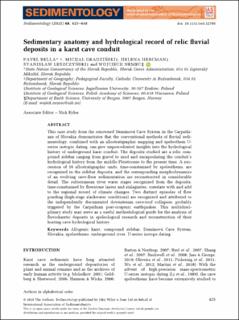Sedimentary anatomy and hydrological record of relic fluvial deposits in a karst cave conduit
Journal article, Peer reviewed
Published version

Åpne
Permanent lenke
https://hdl.handle.net/11250/2766469Utgivelsesdato
2021Metadata
Vis full innførselSamlinger
- Department of Earth Science [1103]
- Registrations from Cristin [10412]
Sammendrag
This case study from the renowned Demänová Cave System in the Carpathians of Slovakia demonstrates that the conventional methods of fluvial sedimentology, combined with an allostratigraphic mapping and speleothem U-series isotopic dating, can give unprecedented insights into the hydrological history of underground karst conduit. The deposits studied are a relic compound sidebar ranging from gravel to mud and encapsulating the conduit’s hydrological history from the middle Pleistocene to the present time. A succession of 10 allostratigraphic units, time-constrained by speleothems, are recognized in the sidebar deposits, and the corresponding morphodynamics of an evolving cave-floor sedimentation are reconstructed in considerable detail. The subterranean river water stages recognized from the deposits, time-constrained by flowstone layers and stalagmites, correlate with and add to the regional record of climate changes. Two distinct episodes of flow ponding (high-stage slackwater conditions) are recognized and attributed to the independently documented downstream cave-roof collapses, probably triggered by the Carpathian post-orogenic earthquakes. This multidisciplinary study may serve as a useful methodological guide for the analysis of fluviokarstic deposits in speleological research and reconstruction of their hosting cave hydrological history.
